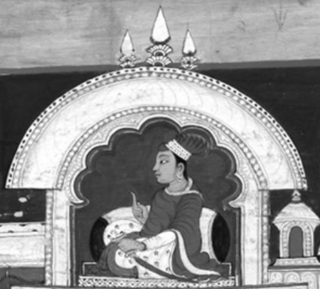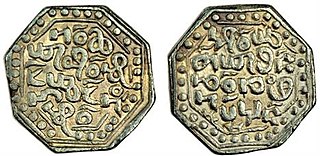
The Ahom dynasty (1228–1826) ruled the Ahom Kingdom in present-day Assam, India for nearly 598 years. The dynasty was established by Sukaphaa, a Shan prince of Mong Mao who came to Assam after crossing the Patkai mountains. The rule of this dynasty ended with the Burmese invasion of Assam and the subsequent annexation by the British East India Company following the Treaty of Yandabo in 1826.

Suhungmung, or Dihingia Roja I was one of the most prominent Ahom Kings who ruled at the cusp of Assam's medieval history. His reign broke from the early Ahom rule and established a multi-ethnic polity in his kingdom. Under him the Ahom Kingdom expanded greatly for the first time since Sukaphaa, at the cost of the Chutia and the Dimasa kingdoms. He also successfully defended his kingdom against Muslim invasions, first by a general called Bar Ujjir and another by Turbak Khan. During his time, the Khen dynasty collapsed and the Koch dynasty ascended in the Kamata kingdom. His general, Ton-kham, pursued the Muslims up to the Karatoya river, the western boundary of the erstwhile Kamarupa Kingdom, the farthest west an Ahom military force had ventured in its entire six hundred years of rule.

Sukhaangphaa was the 4th Ahom king.

Sunenphaa also, Pramatta Singha, was the king of Ahom Kingdom. He succeeded his elder brother Swargadeo Siva Singha, as the king of Ahom Kingdom. His reign of seven years was peaceful and prosperous. He constructed numerous buildings and temples. The most famous of his buildings was the Rang Ghar, which is also considered as the oldest amphitheatre in Asia.

Suklamphaa also Ramadhwaj Singha was a king of the Ahom kingdom. His reign is known for the rise in power of Debera Borbarua and the beginning of a ten-year period of power struggles among high officials of the kingdom that saw quick changes in kings via court intrigues and internal armed conflicts.

Sudingphaa also, Chandrakanta Singha, was a Tungkhungia king of the Ahom dynasty, who ruled at the climactic of the Ahom kingdom. His reign witnessed the invasion of Burmese on Assam and its subsequent occupation by British East India Company. He was installed as King twice. His first reign ended when Ruchinath Burhagohain deposed him and installed Purandar Singha in his stead. His second reign ended with his defeat at the hands of the invading Burmese army. He continued his militant efforts to regain his kingdom as well as to keep Purandar Singha at bay. Finally he submitted himself to Burmese who induced him to believe that they will make him king. Instead he was seized and placed in confinement at Rangpur. After the defeat of Burmese in the First Anglo-Burmese War and subsequent peace Treaty of Yandabo on 24 February 1826 CE, Assam passed into the hand of British. Most of the members of Ahom Royal family were granted pensions. Chandrakanta Singha received a pension of 500 rupees. He first lived in Kaliabor and later on at Guwahati. He visited Calcutta in order to request the restoration of his kingdom but in vain. He died in 1839 CE soon after his return to Guwahati.

Purandar Singha was the last king of the Ahom kingdom in Assam. He was installed as king twice. The first time, he was installed by Ruchinath Burhagohain in 1818 CE, after the latter deposed Chandrakanta Singha from the throne. His first reign ended in 1819 CE, during the second Burmese invasion of Assam when his forces were defeated and the Burmese reinstalled Chandrakanta Singha on the throne. He along with Ruchinath Burhagohain continued their efforts to expel Burmese invaders, by seeking help from the British and through armed struggle. After First Anglo-Burmese War, the British East India Company took over Assam from the Burmese invaders. Finding it difficult to administer an unfamiliar region and sensing discontent among the local inhabitants to foreign rule, the British authorities decided to restore Upper Assam to a prince of Ahom Dynasty. Purander Singha was found suitable for this post and therefore, in April 1833 CE, except for Sadiya and Matak rajya, the entire territory of Upper Assam was formally made over to him, on the condition of yearly tribute of 50,000 rupees. Later, in 1838 CE, finding him incompetent and a defaulter in payments of revenue, the British formally annexed his kingdom, putting an end to a 600-year reign of the Ahom dynasty. When Purandar Singha accepted the position of prince over upper Assam, he did not realize the difficulties of his new position.

Sudangphaa (1397–1407) was the king of the Ahom kingdom. He was popularly known as Bamuni Konwar because of his upbringing in a Brahman's house. His reign marks the first stage in the growth of Hinduism in the Ahom dynasty. He initiated the Singarigharutha ceremony of the Ahom kings, a tradition which was followed by his successors.

Tyao Khamti or Tao Khamthi was the king of Ahom kingdom from 1380 CE to 1387 CE. His accession to the throne put an end to the interregnum in Ahom kingdom, which lasted from 1376 CE to 1380 CE, after king Sutuphaa was treacherously murdered by Chutia king. But his weakness towards his elder queen and to her acts of atrocities towards common people, ultimately led to his own assassination, followed by another interregnum.

Sujangphaa was the king of the Ahom kingdom from 1407 CE to 1422 CE. He was the eldest of King Sudangphaa's three sons. After the death of his father at an early age, Sujangphaa ascended the throne in 1407 CE. Nothing of any importance was recorded in the chronicles of Ahom during his fifteen year long reign. He died in 1422 CE and was succeeded by his son, Suphakphaa.

Susenphaa was the king of Ahom kingdom from 1439 CE to 1488 CE. Contemporary Ahom chronicles described him as a good king and the people under him were happy and prosperous. He ruled for a long period of 49 years. The only trouble which was recorded during his reign was the raids of Tangsu Nagas, which was dealt with the use of force, but not without losses.

Suhenphaa was the king of Ahom kingdom from 1488 CE to 1493 CE. His reign was characterized by the expansion of Ahom kingdom which resulted in conflicts with the Nagas and with the Kachari kingdom. He was successful in the military actions against the Nagas, while in case of Kacharis, he suffered defeat and had to sue for peace with the Kacharis. He was assassinated by one Ahom of Tairungban clan.

Supimphaa was the king of Ahom kingdom from 1493 CE to 1497 CE. In order to exact revenge on the murderers of his father Suhenphaa, he unleashed a reign of terror among people of both high and low ranks alike.

Suteuphaa was the second king of Ahom kingdom who ruled from 1268 CE to 1281 CE. Suteuphaa succeeded his father Sukaphaa, who laid the foundation of Ahom kingdom in Assam. His reign was characterized by the expansion of his father’s kingdom. He also had conflicts with the Shans or Naras of Mungkang, a Shan kingdom in Upper Burma.

Sutuphaa was the king of the Ahom kingdom in late medieval India from 1369 CE to 1376 CE. He ruled after an interregnum and historians differ regarding his year of accession, with some saying his rule began in 1364. His reign was marked by conflicts with Chutia Kingdom, which later resulted in his treacherous murder by the Chutias.

Jogeswar Singha was installed as the king of Ahom kingdom in 1821 CE, by the Burmese. He was more or less a puppet in the hands of the Burmese, who held the real power of administration. His reign witnessed Burmese atrocities on the people of Assam and the attempts made by Chandrakanta Singha and Purandar Singha to expel Burmese invaders. Historians dispute regarding the date of his deposition from the throne, as some historians claimed that he was deposed by his Burmese masters, after they secured complete victory over the forces of Chandrakanta Singha in 1822 CE, while some sources claimed that he remained as a puppet ruler till termination of Burmese rule in Assam by British East India Company, in 1825 CE, during First Anglo-Burmese War.

Sunyatphaa also Udayaditya Singha was the king of Ahom Kingdom from 1670 CE to 1672 CE. After his elder brother Swargadeo Chakradhwaj Singha died in the middle of Ahom-Mughal war, Udayaditya Singha succeeded to the throne. His reign witnessed the end of Ahom-Mughal war, which started during the reign of Chakradhwaj Singha, when the Mughal army led by Rajput prince, Ram Singh I of Amber, was decisively defeated by the Ahom forces led by Ahom commander Lachit Borphukan in the Battle of Saraighat. The later part of his reign was characterized by the failure of military expedition against the Dafala tribes and the influence of Paramananda Sannyasi, a saintly figure from Brindaban, over Udayaditya Singha. Udayaditya's over exerted devotion towards Paramananda Sanyasi, aroused dissatisfaction among the nobles, which ultimately caused his deposition and execution. His reign was followed by a series of political anarchy and internal disturbances in the Ahom kingdom which continued till the accession of Gadadhar Singha in 1681 CE.

Suhung also known as Samaguria Rojaa Khamjang was a king of the medieval Indian Ahom kingdom who ruled for a very short period. While most of the chronicles put the number of days of his reign as 20, in some chronicles the duration of his reign was shown as one month and fifteen days. Suhung was installed as king of Ahom kingdom by Debera Borbarua after the latter poisoned Ahom king Ramdhwaj Singha. His reign was characterized by the atrocities committed by his minister Debera Borbarua. Finally, Suhung decided to get rid of Debera Borbarua and put an end to his reign of tyranny, but the powerful minister outsmarted the king, by secretly poisoning his medicine and killing him.

Sudoiphaa or Tej Singha was the king of Ahom kingdom from 1677 CE to 1679 CE. After deposing king Sujinphaa, Atan Burhagohain, the Prime-Minister of Ahom Kingdom, installed Sudoiphaa in the throne. Sudoiphaa's reign witnessed the end of the ministerial dictatorship of Atan Burhagohain and rise of Laluksola Borphukan, the Ahom Viceroy of Guwahati and Lower Assam, as the real authority behind the throne. In order to gain absolute authority in the Royal Court, Laluksola Borphukan, treacherously surrendered the garrison of Guwahati to Mughals, and held Atan Burhagohain and other nobles as captive. Sudoiphaa's effort to reestablish his authority and bring the ambitious Laluk Sola Borphukan to justice for his treachery against his country and collaboration with the foreigners, finally led to his own deposition and execution by the ambitious minister.

Sulikphaa also, Ratnadhwaj Singha was the twenty-eighth king of the Ahom Kingdom. He was only 14 years of age when Laluksola Borphukan, the Ahom viceroy of Guwahati and Lower Assam, raised him to the throne, after deposing the former king, Sudoiphaa. Due to his young age at the time of his accession, he was generally known as Lora Raja or the Boy-king. His reign was characterized by the atrocities committed by Laluksola Borphukan, who held the real authority behind the throne, in his name. The most notorious act which occurred during his reign was the mutilation of Ahom princes belonging to different phoids or clans of the Royal Ahom Dynasty. While most of the Ahom princes suffered mutilation, Prince Gadapani, the future king Gadadhar Singha, from the Tungkhungia branch of the Royal Ahom Dynasty, escaped, due to the efforts of his illustrious wife, Joymoti Konwari, who refused to divulge any information regarding her husband's whereabouts even in face of the tortures inflicted by the henchmen of Lora Raja. After Laluksola Borphukan was assassinated in court intrigues, the nobles at Kaliabar decided to get rid of the incompetent Lora Raja and put an able prince on the throne. Prince Gadapani, who was living incognito at a place called Rani in Kamrup at that time, was nominated for the throne. Sulikphaa or Lora Raja was deposed and exiled to Namrup, only to be executed later on.




